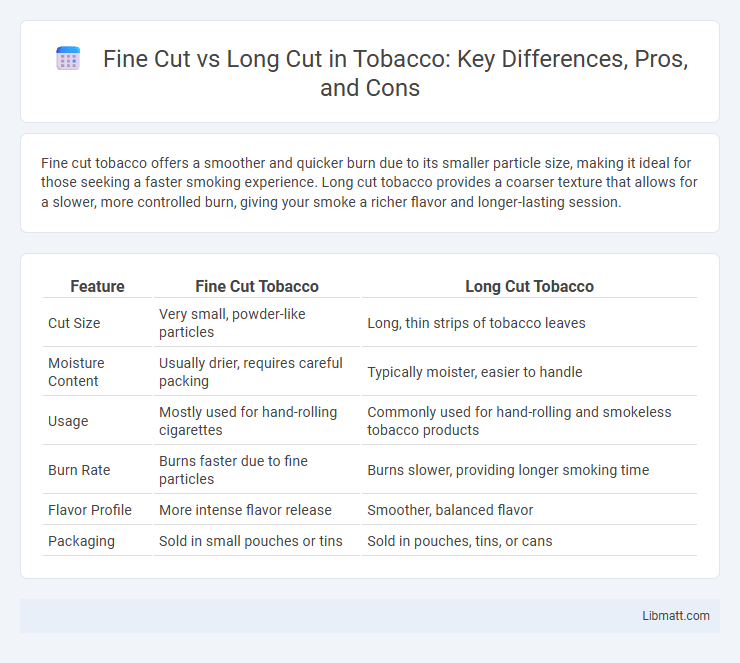Fine cut tobacco offers a smoother and quicker burn due to its smaller particle size, making it ideal for those seeking a faster smoking experience. Long cut tobacco provides a coarser texture that allows for a slower, more controlled burn, giving your smoke a richer flavor and longer-lasting session.
Table of Comparison
| Feature | Fine Cut Tobacco | Long Cut Tobacco |
|---|---|---|
| Cut Size | Very small, powder-like particles | Long, thin strips of tobacco leaves |
| Moisture Content | Usually drier, requires careful packing | Typically moister, easier to handle |
| Usage | Mostly used for hand-rolling cigarettes | Commonly used for hand-rolling and smokeless tobacco products |
| Burn Rate | Burns faster due to fine particles | Burns slower, providing longer smoking time |
| Flavor Profile | More intense flavor release | Smoother, balanced flavor |
| Packaging | Sold in small pouches or tins | Sold in pouches, tins, or cans |
Introduction to Fine Cut vs Long Cut
Fine cut and long cut tobacco differ primarily in the size and texture of the tobacco strands; fine cut features much smaller, finely shredded pieces, while long cut contains longer, coarser strips. These differences significantly affect the user experience, with fine cut often preferred for quicker absorption and ease of packing, whereas long cut provides a slower release and is generally easier to handle. The choice between fine cut and long cut can influence flavor intensity, moisture retention, and overall satisfaction during use.
Defining Fine Cut and Long Cut
Fine cut tobacco features smaller, thinner strands that allow for quicker burning and a smoother, more intense flavor experience. Long cut tobacco consists of longer, thicker strips that require more packing but provide a slower burn and extended flavor release. Choosing between fine cut and long cut depends on your preference for convenience, flavor intensity, and usage duration.
Key Differences Between Fine Cut and Long Cut
Fine cut tobacco consists of smaller, thinner strands, resulting in a quicker burn and stronger flavor intensity, while long cut tobacco features thicker, longer strips that provide a slower burn and milder taste. Nicotine absorption rates vary as fine cut tends to deliver a faster nicotine hit compared to the more gradual effect of long cut. Packaging sizes and moisture content also differ, with fine cut often found in smaller pouches and wetter than the drier, bulkier long cut varieties.
Applications of Fine Cut Products
Fine cut products are ideal for users seeking quick nicotine absorption due to their smaller particle size, making them suitable for discreet use and easy packing in snuff or sachets. These products are often preferred in European and Nordic regions where users prioritize convenience and a smoother flavor profile. Your choice of fine cut tobacco can enhance portability and ease of use, especially in situations requiring subtlety and rapid consumption.
Applications of Long Cut Products
Long cut tobacco products are primarily used by individuals seeking a slower, more controlled nicotine release, which makes them ideal for extended use throughout the day. These products are particularly popular in social settings or during work breaks, providing a less intense flavor and easier handling compared to fine cut varieties. Your choice of long cut tobacco can enhance convenience and enjoyment while maintaining a smoother experience.
Flavor and Aroma Retention: Fine vs Long Cut
Fine cut tobacco offers a more intense flavor and aroma retention due to its increased surface area, allowing for quicker release of essential oils and spices. Long cut tobacco retains flavors longer because its larger pieces burn more slowly, providing a sustained but milder taste experience. Users seeking robust immediate flavor often prefer fine cut, while those valuing prolonged aroma favor long cut products.
Handling and Usability: Which Is Easier?
Fine cut tobacco offers easier packing and quicker burning, making it more manageable for beginners, while long cut demands a steadier hand for proper placement and longer-lasting experience. You'll find long cut more suited for those who prefer a slower, more controlled dip, whereas fine cut provides convenience and quick usability. Handling fine cut tends to be simpler due to its smaller particle size, reducing the chances of spills and improving overall user comfort.
Storage and Shelf Life Comparison
Fine cut tobacco typically has a shorter shelf life due to its increased surface area, which exposes more moisture and oils to air, accelerating drying and flavor degradation. Long cut tobacco retains moisture longer and preserves flavor better during storage because its larger pieces reduce the rate of oxidation and drying out. To keep your tobacco fresh and flavorful, store both types in airtight containers away from heat and humidity, but you may need to consume fine cut more quickly to enjoy its best quality.
Consumer Preferences: Fine Cut or Long Cut?
Consumer preferences between fine cut and long cut tobacco vary significantly, with fine cut favored for its quicker burn and ease of packing, appealing to users seeking convenience and faster consumption. Long cut tobacco attracts consumers who prefer a slower burn and smoother experience, allowing for prolonged use and better flavor retention. Market trends indicate a gradual shift towards fine cut products among younger demographics, while traditional smokers often remain loyal to long cut varieties.
Choosing the Right Cut for Your Needs
Fine cut tobacco offers a smoother, quicker burn suitable for those seeking convenience and fast consumption, while long cut tobacco provides a longer-lasting experience with easier handling. Your choice depends on whether you prioritize portability and speed or a more traditional, gradual enjoyability. Consider how you plan to use the tobacco to select the cut that best aligns with your lifestyle and preferences.
Fine cut vs Long cut Infographic

 libmatt.com
libmatt.com